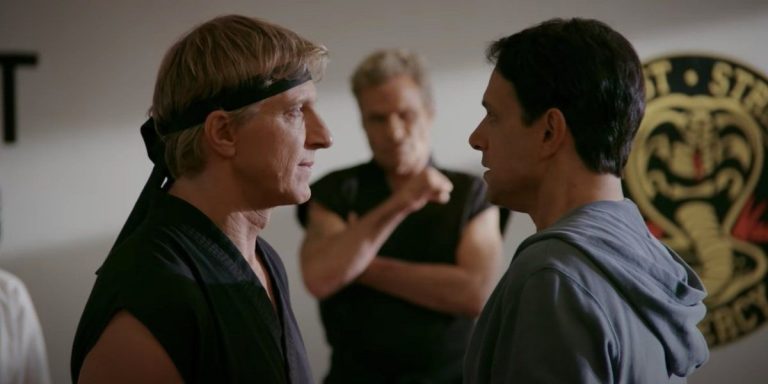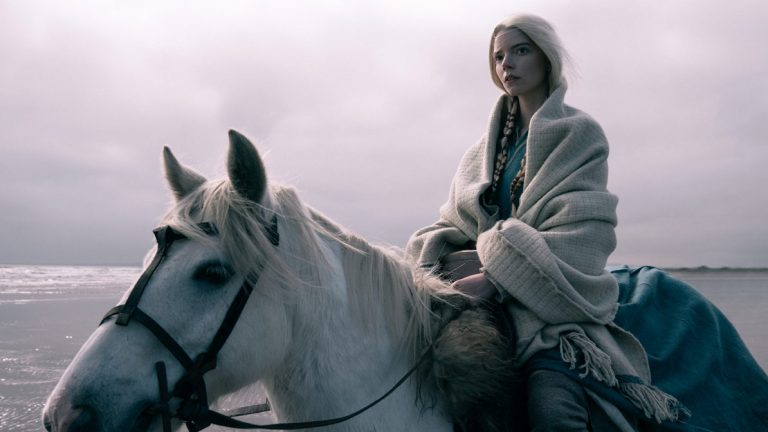With “Rose of Nevada” (2025), writer/director Mark Jenkin splits the difference between his first two films. The Cornish auteur’s latest is steeped in the fishing village imagery and culture of debut “Bait” and infused with the trippy, 70s throwback folk horror of “Enys Men.” The result is a bittersweet sensory journey that’s both whimsical and weary. It’s a somewhat contained film that, true to its subject matter, resonates in the senses and in the unspoken.
“Rose of Nevada” is a haunted dirge of a movie that’s filmed like a sea shanty. Like a more modern, regional Robert Eggers, Jenkin is a stickler for period flourishes and details. In this case, we flit into the 1990s for what has to be one of the weirdest, most indie “Back to the Future” riffs in cinema history. The 16mm, audio overdub aesthetic of Jenkin’s earlier work is very much intact here. Like the ship that gives the film its name, this is a film and filmmaking style that hails from a different era.
One random day, an old fishing boat reappears in the village where it disappeared 30-some odd years ago. The village here – like the one in “Bait” – is another display of precarity. Jobs and money are hard to come by. Modern life appears to have passed this village behind. The ones who remain are those who’ve been there for generations, unable or unwilling to leave.
The exception seems to be George MacKay, who’s a transplant from another part of England. He’s found a bucolic existence with a wife and child, but he needs money to fix their roof. Another man of seafaring age, a drifter sleeping rough played by Callum Turner, is eager for the wages that’ll allow him a room and a pint at the local. As if by serendipity, the two men find a form of employment.
The return of the Rose of Nevada sparks something in the village. Its owner and another knowing resident, as well as the skipper that appears in due time, immediately understand that they need to put together a crew. It’s imperative, we’re told, that the crew is never a man short. The two men who do end up staffing it seem drawn to the boat, and they’re quickly setting off for their haul.
Rose of Nevada’s biggest strength is its use of the sensory. Jenkin turns the clanging of the ship and the stirring of the waves into an immersive, hallucinatory journey that rocks the audience gently through time. His camera bobs and bangs along to the sea as the repetition of the fishing life and the soundscape of the open water lull its crew and the audience into a sort of waking slumber that makes what follows both eerie and endearing.
Where we find ourselves after is a paradox, one that makes “Rose of Nevada” both frustratingly elusive and effortlessly moving. Its wistfulness and its menace wash over simultaneously, and it uncannily communicates the dilemma of its characters: what do you do when you’re welcome where you don’t belong?
Similarly, “Rose of Nevada” both invites and resists interpretation. Jenkin has said that aspects of this film were a response to COVID, and the weight of absence is certainly felt in the views of the village and the weary denizens who march through it. But it continues Jenkin’s exploration of how custom and tradition meet, or fail to meet, modernity. More than this, it asks its characters and the audience to reflect on community, what it means to serve it, and what it means to sacrifice for it.
The premise of “Rose of Nevada” more or less reveals the plot beats, but this is a film of introspective surprise. Even knowing what to expect going in, “Rose of Nevada” is full of understated intrigue. It’s a ghost of a movie, ethereal and mysterious like its titular ship. Jenkin successfully replicates the mood and feel of British 70s folk horror, pulling us back in time. At points, it feels like we’re watching an actual film from the era, free of irony or self-consciousness.
When the film and its protagonists touch dry land again, they respond in different ways. Turner’s drifter is bemused. MacKay, ever the out-of-towner, senses something amiss. Jenkin’s film is laced with just enough clues to make the contradictions his characters face appropriately haunting. The town itself seems to know something that neither we nor the new Nevada crew understands, and the low-key, hushed way in which everyone settles into this new reality is both loving and off-putting.
“Rose of Nevada” ultimately settles on the moral choices of what it means to be part of a community and what it means to endure through history. The central vessel is a way for Jenkin to once again explore how it feels to exist out of time. The struggle to find a place in a changing world defines this story, but it’s the trippy, hallucinatory frame through which Jenkin relays that struggle that resonates most. Like the paradox at its center, “Rose of Nevada” is both fascinating and challenging, and it ends on a hesitant note, resigned to the push and pull of its time period.
Strong performances, a winking British charm, and a tremendous display of craft make this an immersive, intriguing ride. Steeped in sensory detail and entrancing atmosphere, “Rose of Nevada” at times feels almost too contained. Like the claustrophobic ship cabin that transports its characters, it’s a solemn space, intimate and defined by what’s unsaid. However much its opaqueness and stiff upper lip leave unsaid, it has a haunting quality that lingers long after the credits.



![Mangsho [2020] Short Film Review: Raw, Unpleasing and Unforgiving](https://79468c92.delivery.rocketcdn.me/wp-content/uploads/2020/05/Mangsho-768x370.png)
![120 BPM (Beats Per Minute) [2017]: ‘IFFI’ Review](https://79468c92.delivery.rocketcdn.me/wp-content/uploads/2017/12/120BPM_HIGH_ON_FILM_IFFI-768x405.jpg)

![Girl Picture [2022]: ‘Sundance’ Review – A radical albeit slight tale about sexuality, identity & growing up](https://79468c92.delivery.rocketcdn.me/wp-content/uploads/2022/01/Girl-Picture-1-768x432.jpg)
![Android Kunjappan Ver 5.25 [2019] Review: A Sweet and Succulent Surprise](https://79468c92.delivery.rocketcdn.me/wp-content/uploads/2019/11/Android-Kunjappan-Ver-5.25-content-and-featured-768x576.jpg)